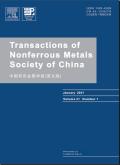具有基态或棱柱态 Mg2Sn 的 Mg-Sn 合金的孪生行为
IF 4.7
1区 材料科学
Q1 METALLURGY & METALLURGICAL ENGINEERING
Transactions of Nonferrous Metals Society of China
Pub Date : 2024-09-01
DOI:10.1016/S1003-6326(24)66577-5
引用次数: 0
摘要
为了定量揭示析出物取向对孪晶行为的影响,采用了具有基态或棱柱态 Mg2Sn 板条的 Mg-Sn 合金。为了研究孪晶行为,对具有基态或棱柱态 Mg2Sn 的 Mg-5wt.%Sn 合金进行了压缩。随后,建立了一个 Orowan 强化模型,以定量研究析出物在孪生时的临界分辨剪切应力(CRSS)增量。结果表明,与基底析出物相比,棱柱形析出物更有效地阻碍了拉伸孪晶的转移和生长。含有棱柱态 Mg2Sn 的拉伸孪晶比例下降可能是由于拉伸孪晶的 CRSS 增量大于基态析出物的 CRSS 增量。棱柱态 Mg2Sn 合金的孪晶转移率明显降低,这可能是由于棱柱态 Mg2Sn 的几何必要位错较高,拉伸孪晶的 CRSS 增强所致。值得注意的是,棱状析出物在压缩过程中对拉伸孪晶具有更好的阻碍作用。本文章由计算机程序翻译,如有差异,请以英文原文为准。
Twinning behaviors of Mg−Sn alloy with basal or prismatic Mg2Sn
The Mg−Sn alloys, with basal or prismatic Mg2Sn laths, were employed to reveal the effect of precipitate orientation on twinning behavior quantitatively. The Mg−5wt.%Sn alloys with basal or prismatic Mg2Sn were compressed to study the twinning behaviors. Subsequently, an Orowan strengthening model was developed to quantitatively investigate the critical resolved shear stress (CRSS) increment of precipitates on twinning. The results revealed that the prismatic precipitates hindered the transfer and growth of tensile twins more effectively compared with the basal precipitates. The decreased proportion of tensile twins containing prismatic Mg2Sn might be attributed to a larger CRSS increment for tensile twins compared with that for basal precipitates. The obvious decreased twinning transfer in the alloy with prismatic Mg2Sn could be due to its higher geometrically necessary dislocation and enhanced CRSS of tensile twins. Notably, the prismatic precipitates have a better hindering effect on tensile twins during compression.
求助全文
通过发布文献求助,成功后即可免费获取论文全文。
去求助
来源期刊
CiteScore
7.40
自引率
17.80%
发文量
8456
审稿时长
3.6 months
期刊介绍:
The Transactions of Nonferrous Metals Society of China (Trans. Nonferrous Met. Soc. China), founded in 1991 and sponsored by The Nonferrous Metals Society of China, is published monthly now and mainly contains reports of original research which reflect the new progresses in the field of nonferrous metals science and technology, including mineral processing, extraction metallurgy, metallic materials and heat treatments, metal working, physical metallurgy, powder metallurgy, with the emphasis on fundamental science. It is the unique preeminent publication in English for scientists, engineers, under/post-graduates on the field of nonferrous metals industry. This journal is covered by many famous abstract/index systems and databases such as SCI Expanded, Ei Compendex Plus, INSPEC, CA, METADEX, AJ and JICST.

 求助内容:
求助内容: 应助结果提醒方式:
应助结果提醒方式:


